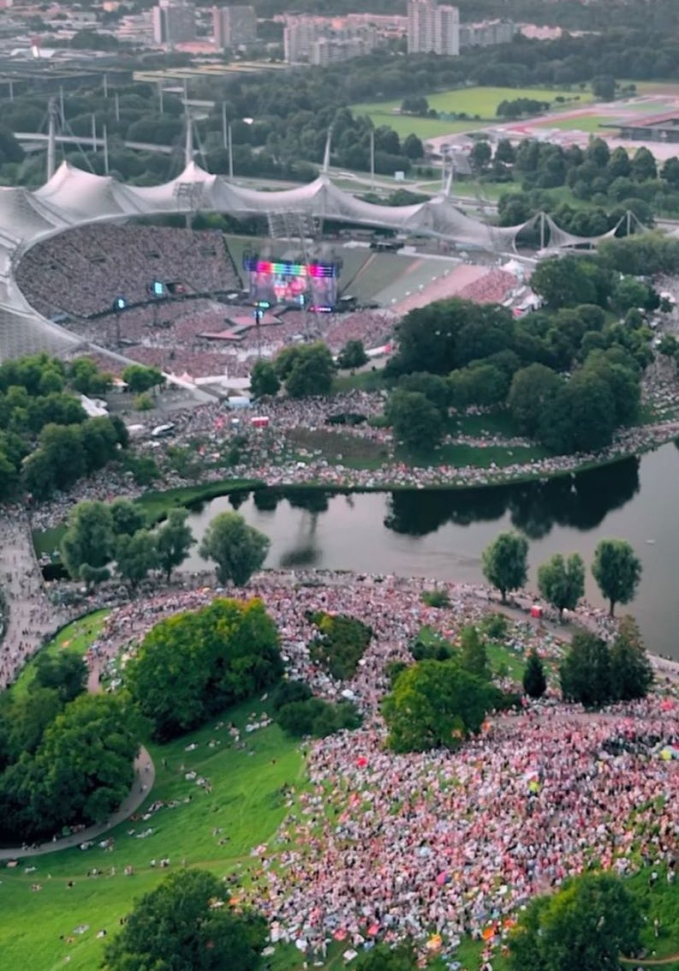The summer of 2024 was nothing short of magical for Taylor Swift fans across Europe, as the global superstar’s Eras Tour swept through the continent like a musical hurricane. From sold-out stadiums to record-breaking ticket sales, the tour has redefined what it means to be a cultural phenomenon. But among the countless unforgettable moments, one night in Munich, Germany, stood out as a testament to Swift’s unparalleled influence. On July 27 and 28, 2024, the Olympiastadion in Munich became the epicenter of a musical earthquake, with 74,000 fans inside and an astonishing 50,000 more gathered on a nearby hill, creating a spectacle that will be remembered for years to come. This is the story of how Taylor Swift turned a hillside into a stage, a crowd into a community, and a concert into history.
The Eras Tour: A Global Juggernaut
To understand the magnitude of what happened in Munich, it’s worth stepping back to appreciate the sheer scale of the Eras Tour. Launched in March 2023, the tour is a celebration of Taylor Swift’s entire discography, spanning her 10 studio albums and countless eras of musical evolution. From the country twang of Fearless to the introspective poetry of Folklore and the bold defiance of Reputation, the show is a three-and-a-half-hour journey through Swift’s career, complete with elaborate costumes, stunning visuals, and surprise acoustic performances. By mid-2024, the tour had already grossed over $2 billion, making it the highest-grossing concert tour in history. Its European leg, which included stops in Paris, London, and Edinburgh, saw millions of fans clamoring for tickets, with some shows selling out in minutes.
Swift’s ability to connect with her audience—known affectionately as “Swifties”—has always been her superpower. Her concerts are more than just performances; they’re communal experiences where fans trade friendship bracelets, dress in outfits inspired by her albums, and sing every word with a passion that borders on spiritual. But in Munich, this connection reached a new level, as the city became the stage for one of the most extraordinary scenes in the tour’s history.
Munich’s Olympiastadion: The Heart of the Storm
On July 27, 2024, Taylor Swift took the stage at Munich’s Olympiastadion, a historic venue known for hosting the 1972 Summer Olympics and major concerts by artists like Beyoncé and The Rolling Stones. With a capacity of around 74,000, the stadium was packed to the brim with fans who had traveled from across Germany and beyond. The atmosphere inside was electric, with Swifties decked out in sparkling outfits, holding up signs, and waving glowsticks. The setlist, a carefully curated blend of hits like “Love Story,” “Blank Space,” and “Anti-Hero,” had the crowd screaming and crying in equal measure.
But what made this night truly unique wasn’t just the scene inside the stadium—it was what was happening outside. Just beyond the Olympiastadion lies the Olympiaberg, a grassy hill that offers a panoramic view of the venue. For decades, locals have known it as a spot to enjoy free open-air concerts, but no one could have predicted the scale of what unfolded during Swift’s shows. Word had spread among fans that the hill provided a vantage point to see and hear the concert, even without a ticket. What started as a trickle of hopeful Swifties turned into a tidal wave, as an estimated 50,000 people descended on the Olympiaberg over the two nights.

The Hillside Phenomenon: 50,000 Fans “Taylor-Gating”
The phenomenon of fans gathering outside concert venues to experience Swift’s shows—dubbed “Taylor-gating” by her fanbase—had already emerged during the U.S. leg of the tour. In cities like Philadelphia and Chicago, hundreds of ticketless fans would congregate near stadiums, singing along to muffled music and swapping stories. But Munich took Taylor-gating to an unprecedented level. The Olympiaberg became a sea of humanity, with fans of all ages spreading out blankets, pitching colorful tents, and setting up beach umbrellas to shield themselves from the summer sun. Some brought portable speakers to amplify the music, while others relied on the stadium’s sound system, which carried Swift’s voice across the park.
What made the hillside scene so remarkable wasn’t just its size but its spirit. Videos and photos from the event show thousands of people singing in unison, dancing to choreography they’d memorized from TikTok, and lighting up the night with their phone flashlights. The crowd included families with young children, teenagers in homemade Evermore-inspired cloaks, and even older fans who’d discovered Swift later in her career. Despite the heat and lack of amenities, the mood was jubilant. Fans shared snacks, traded bracelets, and formed impromptu communities, united by their love for the artist whose music has soundtracked their lives.
Swift herself was clearly moved by the sight. During her Sunday show, she paused to acknowledge the fans outside, saying she’d seen footage of the massive crowd on the hill. Her words were met with roars of approval from the stadium audience, who seemed to revel in the shared connection with their fellow Swifties outside. The moment underscored Swift’s unique ability to make every fan feel seen, whether they’d paid hundreds of euros for a ticket or were singing for free on a grassy slope.

A Cultural Moment: Why Munich Mattered
The Munich concerts weren’t just a logistical marvel—they were a cultural milestone. The image of 50,000 fans on the Olympiaberg captured the zeitgeist, going viral on social media and sparking conversations about Swift’s influence. For many, the hillside crowd symbolized the democratization of fandom: in an era where concert tickets can cost hundreds or even thousands of dollars, these fans found a way to participate in the Eras Tour without breaking the bank. The event also highlighted Munich’s unique geography, as the Olympiaberg’s natural amphitheater-like setting made it possible for such a large crowd to gather safely and enjoy the show.
The scene also spoke to Swift’s enduring appeal. At 34, she’s no longer the teenage country prodigy who burst onto the scene in 2006. Yet her fanbase continues to grow, spanning generations and continents. The Munich hillside was a microcosm of this diversity, with fans from different backgrounds coming together to celebrate an artist whose music speaks to universal emotions—love, heartbreak, resilience, and joy. The fact that 50,000 people were willing to endure high temperatures and limited shade just to be near her performance is a testament to the emotional bond she’s forged with her audience.
The Bigger Picture: Swift’s Impact on Music and Culture
The Munich phenomenon is just one chapter in the larger story of the Eras Tour, which has redefined what a concert tour can be. Beyond its financial success, the tour has had a tangible economic impact, boosting tourism and local businesses in every city it visits. In Munich, hotels, restaurants, and merchandise stalls reported a surge in demand, as fans flooded the city for the weekend. The tour has also inspired a wave of creativity, from fan-made art and videos to academic courses analyzing Swift’s lyrics and business acumen.

Moreover, the Eras Tour has solidified Swift’s status as a cultural icon. Her decision to rerecord her early albums to regain ownership of her masters—a saga that culminated in her purchasing the rights to her first six albums in 2024—has made her a role model for artists navigating the music industry. Her transparency about her struggles, from public feuds to personal heartbreaks, has endeared her to fans who see her as both a superstar and a relatable figure. In Munich, this duality was on full display: she was the untouchable pop goddess commanding a stadium, but also the artist who took a moment to thank the fans watching from a hill.
Looking Ahead: The Legacy of Munich
As the Eras Tour wound down its European leg in August 2024, the Munich shows remained a high point. Swift herself called the experience “magical,” and fans on social media dubbed the Olympiaberg crowd one of the tour’s defining images. The moment encapsulated everything that makes the Eras Tour special: the music, the community, and the sheer, uncontainable enthusiasm of Swift’s fans. It also raised questions about the future of live music. Could other artists inspire similar devotion? Will venues start accommodating “outside” fans in new ways? For now, Munich stands as a reminder of what’s possible when an artist and her audience are in perfect harmony.
For the 74,000 fans inside the Olympiastadion and the 50,000 on the Olympiaberg, those two nights in July were more than just concerts—they were a celebration of music’s power to unite, inspire, and transcend boundaries. Taylor Swift didn’t just perform in Munich; she created a moment that will echo in the hearts of Swifties for years to come. And somewhere on that hill, amid the singing and dancing, a new generation of fans fell in love with the magic of the Eras Tour.